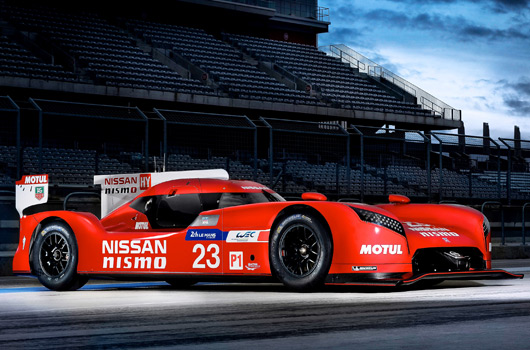 Nissan has just revealed information and photos for its 2015 LMP1 challenger, the GT-R LM Nismo. And if you think it looks a bit wacky just wait until you cop a load of the car’s specifications. The GT-R LM Nismo is a front-engined, front-wheel drive racer. Yes, really, it’s a front-wheel drive; a bum dragger! It has 14″ rubber on the front axle and 9″ on the rears. It is, quite literally, totally arse about compared with what we’re used to seeing in top line motorsport. Remaining relatively true to its GT-R badge the petrol engine is a twin-turbo 3.0 litre V6. Ben Bowlby, Nissan LMP1 Team Principal and Technical Director, is the man responsible for this madness, or perhaps outright brilliance, only time will tell. He explains himself by saying: “The Nissan GT-R LM NISMO is in automotive-speak a front-engined, front-wheel-drive car. The internal combustion engine drives the front wheels and the energy recovery system harvests energy from the front wheels. We’ve used the relatively low-powered internal combustion engine to drive the front wheels and then we add power from the ERS to augment acceleration. “The regulations have allowed us the freedom to create a significantly different looking car. Nissan are bold challengers who are prepared to innovate in order to get a high performance outcome so we’ve turned the whole concept of the conventional LMP1 car of 2014 on its head. The result is that our car looks different as the cockpit has been moved significantly rearwards to accommodate the engine at the front of the car.” Former F1 driver an winner of the 2009 24 Hours of Le Mans Marc Gene has been named as the driver who will lead the charge in the GT-R LM Nismo. He’ll be taking part in the full 2015 WEC calendar and has realistic hopes for the year ahead and is hopeful of a good showing at Le Mans. “This season we should just focus on learning about and improving the car every time we head out onto the track,” Gene explained. “Making it to the finish would already be an achievement on it’s own. I hope we can show that the car is competitive, especially at Le Mans. “I like the aggressive look of the car, which is a consequence of a well-thought and different design, not seen before at Le Mans. From the very first laps I felt very comfortable. I could feel the very powerful engine and high efficiency of the aerodynamics.” This is one wacky racer that will be fun to watch in 2015!
Nissan has just revealed information and photos for its 2015 LMP1 challenger, the GT-R LM Nismo. And if you think it looks a bit wacky just wait until you cop a load of the car’s specifications. The GT-R LM Nismo is a front-engined, front-wheel drive racer. Yes, really, it’s a front-wheel drive; a bum dragger! It has 14″ rubber on the front axle and 9″ on the rears. It is, quite literally, totally arse about compared with what we’re used to seeing in top line motorsport. Remaining relatively true to its GT-R badge the petrol engine is a twin-turbo 3.0 litre V6. Ben Bowlby, Nissan LMP1 Team Principal and Technical Director, is the man responsible for this madness, or perhaps outright brilliance, only time will tell. He explains himself by saying: “The Nissan GT-R LM NISMO is in automotive-speak a front-engined, front-wheel-drive car. The internal combustion engine drives the front wheels and the energy recovery system harvests energy from the front wheels. We’ve used the relatively low-powered internal combustion engine to drive the front wheels and then we add power from the ERS to augment acceleration. “The regulations have allowed us the freedom to create a significantly different looking car. Nissan are bold challengers who are prepared to innovate in order to get a high performance outcome so we’ve turned the whole concept of the conventional LMP1 car of 2014 on its head. The result is that our car looks different as the cockpit has been moved significantly rearwards to accommodate the engine at the front of the car.” Former F1 driver an winner of the 2009 24 Hours of Le Mans Marc Gene has been named as the driver who will lead the charge in the GT-R LM Nismo. He’ll be taking part in the full 2015 WEC calendar and has realistic hopes for the year ahead and is hopeful of a good showing at Le Mans. “This season we should just focus on learning about and improving the car every time we head out onto the track,” Gene explained. “Making it to the finish would already be an achievement on it’s own. I hope we can show that the car is competitive, especially at Le Mans. “I like the aggressive look of the car, which is a consequence of a well-thought and different design, not seen before at Le Mans. From the very first laps I felt very comfortable. I could feel the very powerful engine and high efficiency of the aerodynamics.” This is one wacky racer that will be fun to watch in 2015! 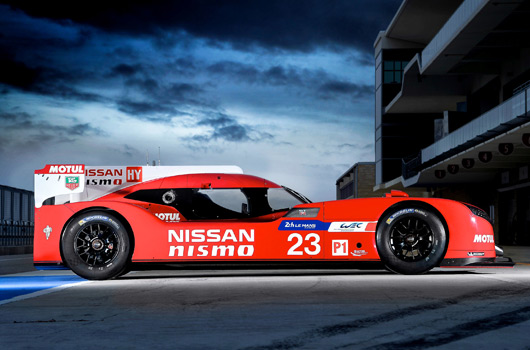
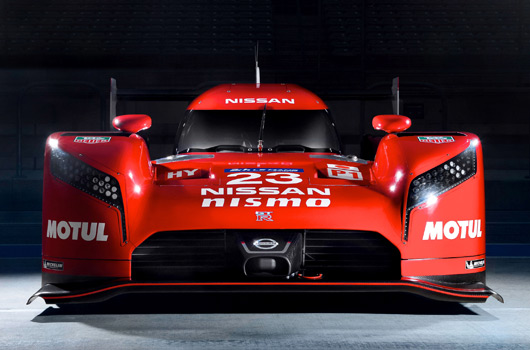
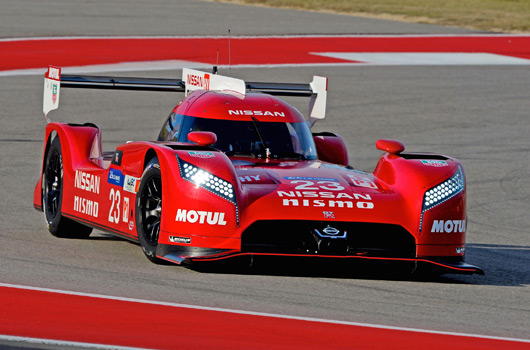
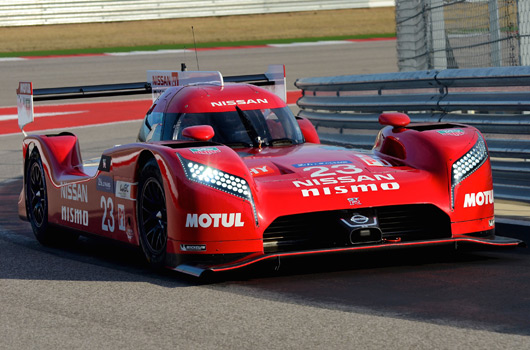
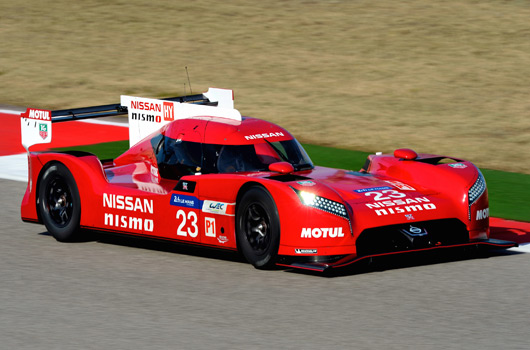
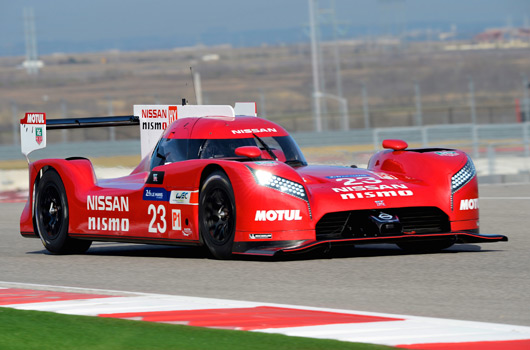
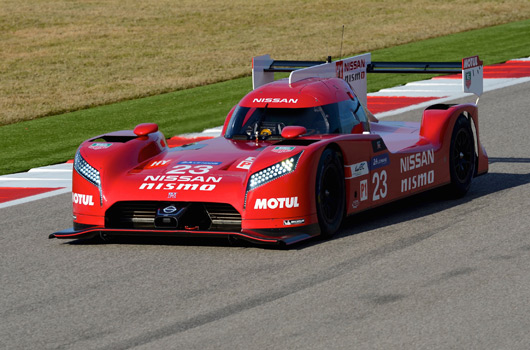
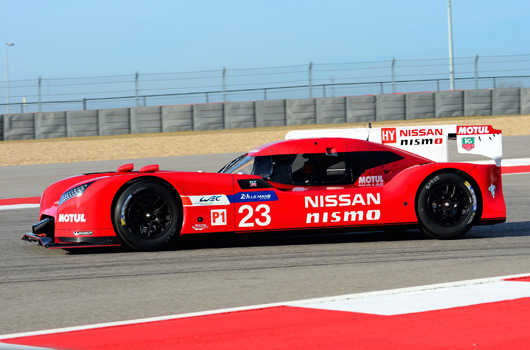
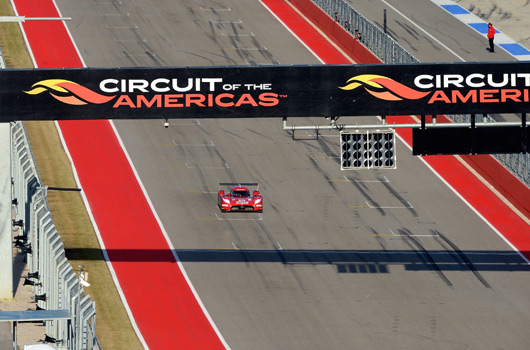
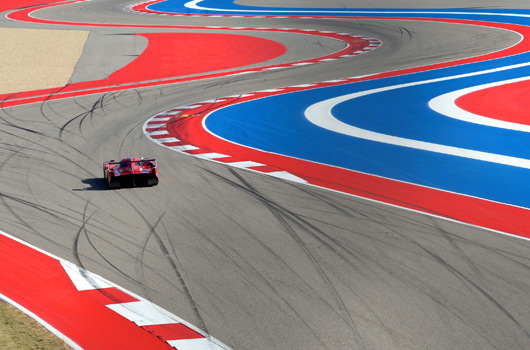
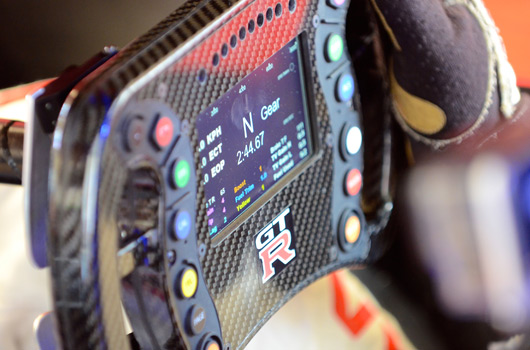
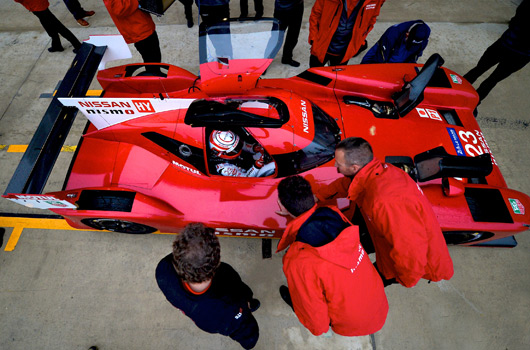
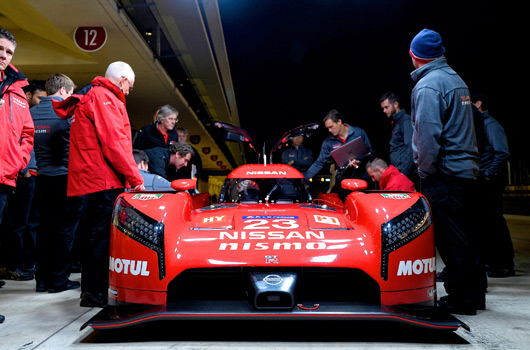
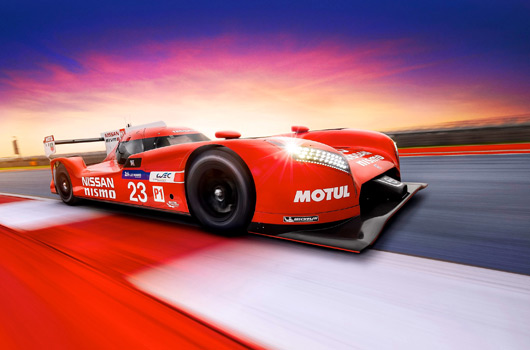
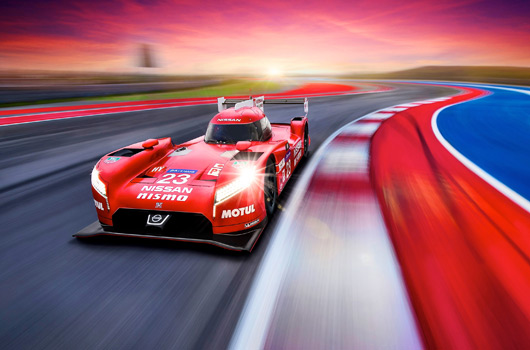
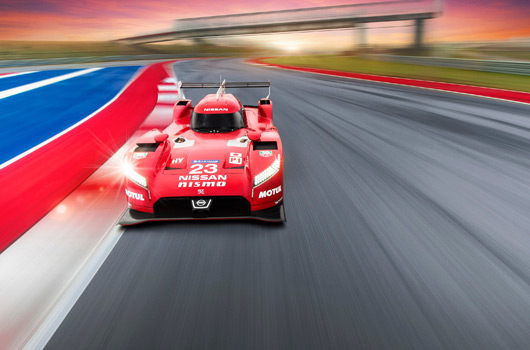
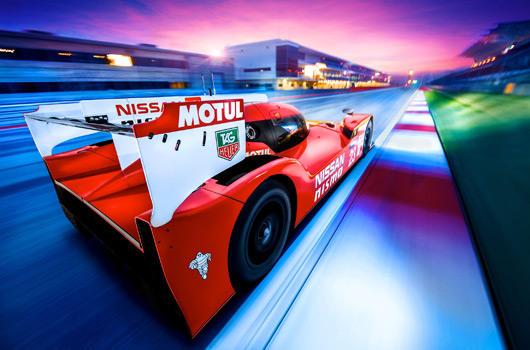
THE 2015 NISSAN GT-R LM NISMO
1 February 2015
NISSAN GT-R LM NISMO Technical Specification
Configuration Front-engine. Front-wheel-drive Engine Nissan VRX 30A NISMO: 3.0 litre, 60 degree V6, direct injection gasoline twin-turbo Transmission 5-speed + reverse sequential gearbox with pneumatic paddle shift system. Epicyclic final drive reduction with hydraulic limited slip differential. Tilton 4-plate carbon clutch assembly. Chassis FIA Homologated, weight: 880 kg. Right-hand driving position. 68 litre capacity FT3 fuel tank featuring electric lift and feed pumps. ERS housed ahead and beneath driver’s feet in self-Ââ€contained module. Bodywork Carbon-composite body panels. Polycarbonate windscreen with hard coating CFD and full scale wind tunnel developed ultra high efficiency bodywork geometry, adjustable rear wing. Suspension Penske dampers with four-way adjustment front and rear, hydraulic rear anti-roll bar system. Brakes 6-piston front and 4-piston rear calipers. NISMO Brake-by-Wire active brake ERS blending. Driver adjustable brake bias. Wheels BBS centre-lock, magnesium forged 16â€x13†front and 16â€x9†rear Tyres Michelin 31/71-16 front, 20/71-16 rear radials Electrical Cosworth engine control unit featuring: Engine control, gearbox control; Driver adjustable traction control, Anti-lag system control, Brake-by-wire, lift-and-coast fuel conservation, Drive-by-wire throttle control and ERS deployment strategy control. Interior NISMO 5-point harness. Lifeline lightweight extinguisher system. Data / display system Cosworth Electronics with NISMO steering wheel mounted LCD. Dimensions Length: 4.645m Width: 1.9m Height: 1.03m Minimum weight: 880kg Full tank capacity: 68L
Introduction
The Nissan GT-R LM NISMO is the ultimate Nissan GT-R, the purest expression of innovation that excites. Competing in LM P1, the premier class of world sports car racing, Nissan’s Le Mans car is like no other car before it. A truly global effort, the GT-R has been created by a team of carefully selected experts in Japan, the US and Europe. Unlike other LM P1 cars, the GT-R’s V6 3-litre twin turbo petrol engine sits in the front of the front-wheel-drive car, while the hybrid power is harvested from the front driveline to augment acceleration. The man best placed to describe Nissan’s innovative LM P1 car is Ben Bowlby, Nissan’s LM P1 Team Principal and Technical Director.
Can you explain the how the different power sources work on the GT-R?
“We have a very modern but conventional V6 3-litre twin turbo petrol engine. This is a very efficient engine so it produces a large amount of power using the allotted fuel flow limit. The fuel flow limit is one of the new regulations at Le Mans – we’re not limited by the engine capacity or the boost pressure or the RPM of the engine – we’re limited by how many grammes of fuel per second we can burn. So the more efficient you make the engine the more power you have because you are still burning the same amount of fuel whether you are efficient or inefficient so if you can make a very efficient engine you get a lot of power. We are burning a smaller amount of fuel, around 30% less than was used by a petrol engine at Le Mans in 2013, for example. “So we have a petrol engine efficiently producing a certain amount of power and then in addition to that we are using a kinetic energy recovery system (ERS). The car is a mass, travelling at velocity and as we slow it down for the upcoming corner we harvest that kinetic energy. “We can then deploy that stored energy to accelerate the car out of the corner and because the energy recovery system can release the stored energy very quickly it makes it very powerful. Energy divided by the speed you release that energy = power. Think about a stick of dynamite. That’s actually quite a small amount of energy but it is released in a spilt second so it makes a very big bang. The same amount of energy released over a day would hardly even manage to power a light bulb. So it’s all about how fast you release the energy. We want to release the energy very quickly to get the car back up to speed very quickly because it’s nice to spend lots of time at high speed! The key is to store the energy and then release it very quickly and that’s what makes our system very competitive, providing us with a good amount of power from the ERS, which we can add to the internal combustion engine’s driving power.â€
Is the GT-R a front-wheel-drive car?
“The Nissan GT-R LM NISMO is in automotive-speak a front-engined, front-wheel-drive car. The internal combustion engine drives the front wheels and the energy recovery system harvests energy from the front wheels. We’ve used the relatively low-powered internal combustion engine to drive the front wheels and then we add power from the ERS to augment acceleration.â€
If the GT-R has all this power, will it be faster than the other manufacturer’s LM P1 cars?
“The LM P1 regulations for manufacturers have four hybrid powertrain options, defined by how much hybrid energy is released from the ERS per lap of Le Mans (the Le Mans track is used as the baseline circuit). You can go in the 2 megajoule class where you can deploy up to 2MJ of energy during one lap of Le Mans and also use quite a lot of fuel. You can go in the 4MJ class and get a little less fuel, the 6MJ class with less still and then there’s the 8MJ class where you get the least fuel of all but the most recovered energy for deployment and there’s no limit on how powerful the system is, just how much energy is used so you can either have an awful lot of power for a very short time or a small amount of power for a very long time. “The fuel energy you have, which again can be measured in megajoules, gets cut in proportion to the amount of megajoules you get from your ERS. The way it is worked out by the governing body – the FIA and the ACO – is that if you choose to recover more energy and deploy that you actually end up with more total energy, even though your fuel energy has been cut slightly. The more megajoules you have the faster you go. Each megajoule is worth an amount of time per lap so if you are an 8MJ car compared to a 2MJ car you should be faster over the course of a lap. “There are however some very big challenges, one of which is that you have to get the car down to the minimum weight because every 10-12 kilos is about half a second a lap around Le Mans so if you have more weight in the car that slows you down pretty significantly. The challenge is to package a big, powerful energy recovery system without going over the weight limit and that is very hard to do. We’re going to be really challenged to make our weight target of 880 kilos for 2015 when half of the weight of the car is the powertrain: engine, ERS and the driveline – so that’s a very big challenge.â€
What about the tyres? The rears look narrower than the front tyres!
“The front tyres on the Nissan GT-R LM NISMO are bigger than the rear tyres – 14 inch wide front vs. 9 inch rear. This is due to the way that mass is distributed in the car. We have moved the weight bias forwards to give us traction for the front-engined, front-wheel drive. We’ve also moved the aero forwards so we’ve moved the capacity of the tyres forward to match the weight distribution. So the aero centre of pressure, the mass centre of gravity and the tyre capacity are all in harmony and that means we have bigger tyres at the front than the rear.â€
Why doesn’t the Nissan GT-R LM NISMO look like the other manufacturer’s LM P1 cars?
“The regulations have allowed us the freedom to create a significantly different looking car. Nissan are bold challengers who are prepared to innovate in order to get a high performance outcome so we’ve turned the whole concept of the conventional LM P1 car of 2014 on its head. The result is that our car looks different as the cockpit has been moved significantly rearwards to accommodate the engine at the front of the car.â€
Download
- Nismo LMP1 2015 press kit (3.7mb PDF)
6 replies on “2015 Nissan GT-R LM Nismo revealed”
I love the idea of this. It just turns the argument on its head that a competitive racing car needs to be RWD! Btw Lima, it’s 13″ at the front not 14.
There’s conflicting info on the tyre size Way. Some of Nissan’s own material states 13″ and some states 14″, the latter appears to be the accepted size at this stage.
Looks like one of those wacky cars in gran turismo that you can unlock by finishing the game!
It will interesting to see how it goes. I really like the idea of thinking outside of the square. However, I do wonder to what degree it is contrarian just for the sake of it. Certainly it has achieved lots of free publicity!
I will lol so hard if this thing is fast and we see a FWD winning Le Mans.
You know what I’d love to see? Instead of qualifying for the LM24 going by lap times, have the prototypes and GT cars contest two separate 20 lap qualifying races (minimum four laps for each driver) with NO restrictions on energy usage, energy recovery or fuel flow and no tripping up over cars of other classes.
We need to find out how FAST these cars can actually go, not just how fast the FIA’s limits will let them go!
[…] has withdrawn its radical new GT-R LM Nismo from the opening two races of the WEC season in order to focus on its Le Mans […]